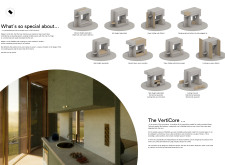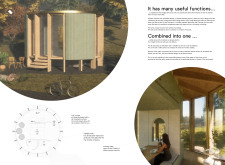5 key facts about this project
The VertiCore microhome is designed to maximize space and functionality in a compact form. With an emphasis on both efficiency and sustainability, it answers the needs of modern living. This microhome is suitable for various settings, both in urban areas and rural locations. Its design revolves around a central core that integrates essential living functions while embracing flexible living arrangements.
Modular Design and Flexibility
The layout focuses on modularity, featuring a vertical elevating system that allows for easy transformation of spaces. This includes height-adjustable components like a shower, sink, and bed. They can be adjusted quickly to create different living or sleeping areas as needed. The elevating table enhances this versatility, ensuring the microhome can adapt to various daily activities without the need for permanent alterations.
Foldable Wall Systems
A key feature of the VertiCore is its use of foldable walls, known as Molo. These lightweight paper partitions provide the ability to create separate rooms or open spaces according to the user's needs. When not in use, these walls can be efficiently folded down to save space. This adaptability not only increases functional use but also helps the microhome feel more spacious and accommodating.
Sustainable Integration
Sustainability is an important element of the design. The microhome includes a rainwater collection system that helps manage water resources efficiently. Additionally, it has built-in battery systems that allow for charging through physical activity, such as using a bicycle. This promotes independence from standard energy sources and reflects a growing concern for environmental issues.
User-Centric Details
Designed with the user in mind, the VertiCore features movable cabinetry that offers customizable storage. This allows for personal choice in layout and organization, helping residents adapt the space to their specific needs. Overall, the design combines practical efficiency with the opportunity for personal expression, creating a living environment that aligns with modern values of flexibility and sustainability.
In detail, the microhome represents a thoughtful response to contemporary housing challenges, reflecting the balance between functionality, efficiency, and individuality.






















































